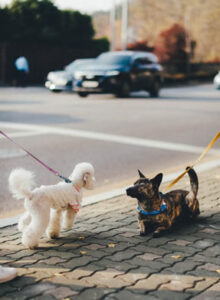The most common mistakes we make when walking a dog. Walking is a fundamental routine for dogs, since it is the time when many dogs take advantage to urinate and defecate. However, the walk offers many other benefits, such as the possibility of socializing, receiving stimulation from the environment or exercising. Generally due to ignorance, many owners make certain mistakes during the walk that directly affect the well-being of their dogs. You want to know the most common mistakes we make when walking a dog, and how we can avoid them, Continue reading this interesting article and you will discover how you can have a great walk with your dog.
Do not let your dog smell the environment
It is normal for you to suffer a slight feeling of rejection when you observe your dog smelling urine and dirt from the ground. However, it is an instinct of your pet that you should not repress. When a dog carries out this behavior two very important things happen:
They relax: Stressed dogs or those who are very restless will benefit from smelling their environment without pressure. It allows them to relax and channel their nervousness.
They receive information about the environment: urine informs your dog of who lives in the same area: if they are males, females or puppies. All this helps you to orient yourself and better understand where you live and who travels through your area.
If your dog is properly vaccinated you do not have to worry, he will not catch any infection. Of course, you can choose to walk through more wooded places to avoid the excessive dirt caused by an urban environment.
But what happens when a dog doesn’t smell anything? If your dog seems to show no interest in smelling other urine, flowers or corners it may be a stress problem.
If during the walk, you observe your dog nervous or upset, you can teach your pet to smell his environment through the following steps:
- Place yourself in a wooded or minimally clean place.
- Look for uneven terrain
- Spread some of the dog’s food or treats on the floor.
- Wait for the smelling dog to find the food.
- If your dog can’t find him, help and guide him.
Pull the leash when the dog also pulls it
Let’s be honest with you: you’re not going to achieve anything by pulling. Believe it or not, leashing your dog causes stress and possible health complications such as intraocular pressure or throat problems. Stop doing it immediately.
To prevent a dog from throwing the leash you must teach him to walk next to you, but if that is not possible or if your dog is very large and you need to have it controlled in certain situations, it is best to buy an anti-pull harness.

Yelling or hitting your pet when he gets angry with another dog
Of course this attitude is totally reprehensible: you should never hit a dog. If you notice that barks or tries to attack other dogs you have to go to a professional; leave the site quickly or, at least, inform yourself about the guidelines you should follow, always using positive reinforcement. By punishing a dog in the presence of others, you are causing it to associate the other dogs with negative things, so aggressiveness can increase.
Just as you would with a child, you should try to make your dog feel good and help him overcome his problems or fears in the right way. Using aggressiveness will only make your dog have a hard time and his relationship with the other dogs can not improve.
The best way to educate a dog is by teaching it how to behave. If during the walk you are nervous, tense and aggressive, the animal itself will perceive it and feel the same. It is better to offer him a quiet and relaxed walk avoiding situations that can trigger a negative reaction.
Do not allow him to interact with other dogs or people
Except for dogs that have aggressive behavior with others, it is very important that we let our dog relate to others. It is essential that animals can relate to each other.
You can go to a dog park or simply find a dog from your same area to walk with. Sometimes conflicts will arise but that does not take away the desire to relate to him, it is very important to ensure that he remains a social and affective dog.
Taking a walk that is too short or too long
You must understand that each dog is unique and has its own needs, in terms of walking habits. For example, more nervous dogs will need more walking time. On the other hand, older dogs, or those who must have less exposure to intense heat should take shorter walks.
You must analyze the needs of your dog in a concrete way and exercise it if necessary with different physical activities, always adapted to him and his pace.
.Usually, a dog’s walk should last between 20 and 30 minutes and should be repeated between two and three times a day.
Strive to offer a proper walk to your dog and you will observe better behavior, attitude and happiness in his eyes.
Let it bite the strap
Although this behavior may indicate excitement and joy from the walk; it is also showing us that the dog is upset and somewhat stressed. In addition, the straps usually have metal elements, something that can damage the teeth of our best friend. For that reason, if your dog nibbles on the leash, the best thing you can do is carry a biter or other type of toy to distract him.
Do not put a nameplate
This point is especially important in those dogs that are afraid of cars, people or generalized fear; as they could unintentionally escape in a stressful situation. Still, it is also important in stable or well-trained dogs. The sheet metal is a fundamental element; as well as the chip, since in case of loss it would be a fast track to recover it.
Do not vary the route of the walk
It is very important that, from time to time, we vary the route of walks; so that our dog feels stimulated by new environments, dogs and objects that our locality offers us. It is always desirable to go to wooded environments full of vegetation or beach areas; but if it is not possible, it will be enough to change streets and bet on a new route.
Do not leave them 5 minutes free without a leash
Many ethologists and canine educators agree that leaving five minutes a day of freedom without a leash offers our dog an extra stimulation and well-being. In that period, we allow him to explore an environment on his own, something very positive for him. If our dog does not respond well to training it is always advisable to go to a fenced area.
Not being attentive to the dog
To finish this list we want to remind you of the importance of being attentive to our partner throughout the walk. It is essential to prevent them from eating anything from the ground or; simply, to detect their body communication and better know what things they like and what they dislike.
Even so, remember that walking is the dog’s time; so dedicating all your effort to make him happy and lively during this time of day is your obligation.
Make every walk a wonderful time for him! The most common mistakes we make when walking a dog.









Discussion about this post